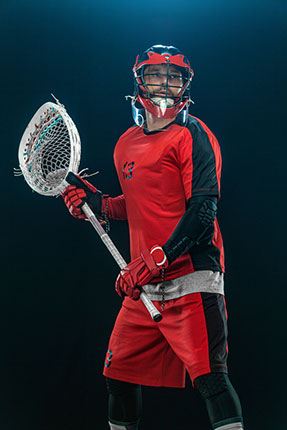Are you a lacrosse player looking to be at your best and ready to dominate on the field? If so, then it's time for an upgrade in your game.
With this guide, you'll get the comprehensive information you need to become an unstoppable force on the field and dodge opponents.
The best tips, tricks, and drills on how to dodge in lacrosse are included here. Read along as we reveal valuable knowledge that will refine your skillset and leave others behind!
More...
Take Away Key Points:
If you want to take your game to the next level, you must learn lacrosse dodging. There are various techniques, but you can begin with these basic lacrosse dodges and advanced lacrosse dodges to be a better lacrosse player and beat the defense.
So let's start with the basic dodges to see how you can improve your game.
What is a lacrosse dodge?

Lacrosse is a sport with different tactics and strategies to use.
A dodge is a move often used when shooting, passing, or pivoting. It's an essential skill for lacrosse players and helps them as they maneuver around opponents. Dodges don't focus on the perfect moves but on reading the defense.
Dodging can be split into different categories: power dodges, hands-free dodges, and stick fakes.
Power dodges involve using the body to fake out an opponent by rolling different body parts in different directions.
Hands-free dodges involve using different hand movements that help keep the ball away from defenders.
Stick fakes are the most critical move of all. It requires you to deceive your opponents by generating an illusion that you're doing something different than you are!
As does any part of lacrosse, practice makes perfect with these different types of dodges; working on reaction time is vital for a successful dodge!
Why is dodging important in lacrosse?
Dodging is important as it creates a chance to shoot, pass or feed the ball to a teammate and make more opportunities to score a goal.
Why do players use different lacrosse dodges?
Lacrosse players use different lacrosse dodges for several other reasons. While many of these various dodges revolve around tricking the opposition into thinking one direction to free up space for a player, it can also be used as an effective defensive maneuver.
Different lacrosse dodges can help a player avoid contact or double-teaming by changing the direction of their movement quickly and efficiently. For example, if a defender wants to push the attacker off the course, the dodge will help the offense gain more power and beat the defender.
Additionally, different lacrosse dodges help to confuse defenders and stack the advantage in favor of the offense. Therefore, knowing when to employ different dodge techniques will help give any lacrosse player an edge against their opponents.
Who can dodge in lacrosse?
In lacrosse, everyone on the field can execute a dodge maneuver, not just the attackers. The dodging tactic is used to move around defending players and gain open space to pass or shoot for a goal.
Each player has their own set of skills and strategies for executing a successful dodge. The technique behind dodging often involves deception and faking out an opponent by dodging in one direction but passing in another.
While attackmen tend to make more use of dogging, it's also an essential tool for midfielders and defenders who need to get around opponents effectively and create a good shooting opportunity.
With practice and experience, all players on a team will be able to dodge successfully and work together during matches to create fascinating plays.
How to dodge better in lacrosse?
Mastering lacrosse dodging drills is critical for any lacrosse player looking to take their game to the next level. The most important element of successful lacrosse dodging is a combination of speed and agility.
To improve your lacrosse dodge, focus on lacrosse dodging drills emphasizing quickness and reaction time, such as sprinting, shuffling, and high knee drills.
Moreover, practice these same footwork movements while holding a lacrosse stick. This will develop muscle memory and make it easier to dodge during an actual lacrosse game.
Lastly, make sure that every lacrosse drill focuses on maintaining body control. For example, successful dodging requires picking up the ball and changing directions while maintaining ball possession.
Follow these strategies and be ready to dominate any lacrosse defender with your improved dodging abilities. Of course, you must practice the dodges repeatedly until they are your second nature.
Can professional lacrosse players advance their lacrosse dodge techniques?
If you are looking to up your dodging game in lacrosse, there are several things you can do.
First, practice your stick skills and footwork as much as possible. Don't forget to include some time for plyometrics exercises to help increase explosiveness.
Secondly, when participating in drills that focus on dodges or during scrimmages, focus on keeping one hand on your stick at all times, no matter which direction you're moving.
Finally, practice with a defensive partner if possible. This will help you understand how the defender is anticipating movement and allow you to anticipate their reactions. You can also develop new strategies for effective dodging.
Different types of lacrosse dodges
Here are some of the most popular basic and advanced lacrosse dodges to help you control the ball and your lacrosse stick better.
1. Roll dodge
Lacrosse players use the roll dodge to confuse the defensive players. You can use the roll dodge to change direction quickly. You will throw the defensive players off balance as they attempt to check in the opposite direction where the offensive players pass them.
The roll dodge is known for its inside roll movement. The inside roll dodge is ideal for increasing a shooting angle and getting a higher percentage on the crease.
The main focus in the inside roll dodge is to seal the opposing defender with your butt and protect your stick at all costs. Once you do this, the defender won't stand a chance to get to your stick.
However, due to the inside roll dodge, the wholesome roll dodge is also considered an advanced dodge instead of the primary dodge.
This great dodge can be done in the following way:
- Use the left hand and right foot to start the dodge
- Push the defender to avoid back rolling into your left hand
- You need stutter-step or pause to reach the opposing defenders
- Pivot backward by changing direction - you should feint in one direction and then roll around the opposing defenders
- Finally, sprint away in the other direction, and you will pass by the defender
Various beginner and advanced lacrosse players do this useful dodge to practice their speed and agility more.

2. Split dodge
Lacrosse split dodge is one of the most popular lacrosse dodges. The split dodge is a quick north-south lacrosse technique used by lacrosse players while running toward the cage.
Lacrosse split dodge is used when you're cutting behind the defender. If you change face dodge and split dodge, you will create further confusion in the lacrosse field.
To perform the split dodge, you can use the same mechanics necessary for the face dodge. However, in the split dodge, you switch hands, and the stick goes from one hand to another.
3. Bull dodge
Bull dodge is one of the most exciting lacrosse dodging skills. The bull dodge only looks aggressive and intimidating, but it's not. Bull dodge is more of a tactic than a dodging technique.
However, to perform the bull dodge, you must be a big and strong lacrosse player to pull it off physically.
To execute the bull dodge drill, offensive players must do the following:
- Hold your lacrosse stick in your dominant hand, and use the other arm to create an L sign. You should make the L sign with the hand with which you're holding off the opposing defender.
- Ensure you don't push the defender or extend your arm guard into a defender, as you risk earning a penalty for your tricks.
4. Question mark dodge
The question mark dodge is a developed version of the roll dodge, often used to score from the shooting position behind the cage. If you can perform the question mark dodge well, you will create enough space for a quick shot.
To complete the question mark dodge successfully, lacrosse layers need to:
- Sprint straight out until you are approximately five yards past the goal line
- Execute a wide curling move to the left or right, and turn at the end to face the goal.
Rob Pannell, a famous lacrosse player, was the first to invent the question mark dodge.
5. Face dodge
Face dodge is another popular speed dodge, as it doesn't require changing direction and doesn't slow your run. Face dodges are the most popular lacrosse dodges for an offensive player.
The face dodge works in a way that requires the full speed of the attacker, but it causes the defender to change direction instead. Thus, the opposing defender is off balance, and you can create space to pass him and shoot at the goal.
You can always find the face dodge drill at collegiate-level lacrosse and professional games. Still, nowadays, even youth lacrosse uses the speed doge to improve their flexibility, footwork, and agility.
To perform the face dodge properly and pass by the defender, a lacrosse player must approach the opposing team as if passing to the opposite side. However, instead of the opposite side, the attacker will continue to the side he has picked and pass by the defender.
Players like Myles Jones or Sergio Perkovic are well-known for their face dodge techniques.
6. Swim dodge
The swim dodge is another exciting lacrosse doge on the list. However, it can be your hidden card to pass by the defender who performs properly on the field.
The swim dodge is similar to the split dodge. However, it requires a change of direction, a jab step at full speed, and switching hands to hold the lacrosse stick while dodging.
The dodge's primary benefit is avoiding any potential poke check the opposing defender might throw. In addition, the defender will not expect the attacker or ball carrier to pull the swim dodge off and run past him.
However, the dodge has a downside. It has a high risk of failure, but if you attempt to succeed, go for it.
To use the swim dodge, lacrosse players should:
- Run at full speed with shoulders squared toward the defender
- Force the defender into the backpedal by attacking his top foot
- Step hard into your cradling position
- Change direction after the plant foot movement
- Lift the stick up and over the defender with your top hand and switch the direction
- Speed up by the defender
- Once the defender is left back, you can change your hand to hold the stick
7. Hitch and drive dodge
The hitch-and-drive lacrosse doge is one of the most common techniques to create separation from the defender. The dodge requires a specific body language as if you were to take a shot, but you change your mind and drive straight forward. Thus you will create separation from the defender.
It's vital to keep your eyes on the ball and the target instead of the defender. Thus, you will pass by the defense, they might lower their guard, and you can shoot more effectively.
8. Roll at the X dodge
The roll-at-the-X dodge is an effective technique when you want to shoot from the X position behind the cage.
You need to continue with the attack before your roll. In addition, you can also look like you're going to feed the ball before using the roll dodge. It's similar to the roll dodge lacrosse drill, but the roll at the X position will maximize stick protection.
Moreover, instead of changing hands, you will keep the stick in front of your body after you change direction, which is slightly different than the advanced roll dodge. But you can still use the roll dodge to advance the technique.
9. Drive, bounce & re-drive dodge
Attackmen should often apply the drive, bounce & re-drive dodge technique to improve their skills. The moment you bounce away from the defender gives you more time to decide what to do next. In addition, you will have a moment to re-drive so that you won't lose anything.
You can combine other dodges, step ahead with your right foot or left foot, match feet, perform a split dodge, feed or shoot, and perform different dodges and techniques to confuse the defender and beat him.
Once you bounce away from the pressure, you should keep the head of the stick and your hands up to protect the stick in the drill.
10. Change of speed drill
The change of speed dodges does not require changing direction, but players only need to change their speed. The dodge requests you to jag, slow down, and then sprint.
You can measure the change of speed dodge in percentage. For instance, a player might come to the dodge at 50% of the speed, slow down to 30%, and finally, continue with 100%. A player can try many different variations to complete the dodge.
Time is crucial here; you can use it to slow down and speed up. In addition, it will create opportunities for separation and keep your hands free when you empty possession of the ball.
11. Toe drag dodge
The toe drag lacrosse dodge is an excellent way for any player to create space on the field. You can move the ball by dragging one foot and quickly changing direction without committing the offense of traveling. This requires quick agility and coordination, making it one of the more complicated dodges in lacrosse.
To execute this move, you need to do the following:
- Hold your stick in one hand, then step forward with your back foot, using your toes to drag the ball.
- As this happens, push off with the front foot while spinning away from defense and toward an open space.
- This combination of a step and spin should throw off defenders trying to cover you and make them think twice about rechallenging you.
Proper technique is essential as well. For example, using too much power when moving through the toe drag dodge can result in a turnover and be ineffective against prospective opponents.
With practice, mastering the toe drag lacrosse dodge can help you become an even more dangerous offensive threat on the field.
Common dodging mistakes & how to avoid them

Lacrosse players often make numerous mistakes while dodging, resulting in turnovers or lost opportunities for shots on goal.
One common mistake is failing to scan the field and look for passing options, which can be costly given how critical quick ball movement is in lacrosse.
Another mistake players make is over-dodging without purpose - pivoting as if to change direction. But, then, they would suddenly re-pivot back without an endgame, like a defender switching or creating space for a pass or shot.
To avoid these errors, players need to be proactive about scanning the field for open teammates and have a game plan in place before starting the dodge so that each movement has a clear objective.
Additionally, rather than spending time on feints and other movements designed primarily to draw defenders away from the ball carrier, focus instead on quickly yet strategically moving with the ball toward a target.
The most famous dodging lacrosse players
Lacrosse has a strong cult following, and the talented players who perform dodging maneuvers during the game can be considered celebrities in their own right.
Some of the most famous names in dodge lacrosse include Paul Rabil and Kyle Harrison, both of whom are former Major League Lacrosse (MLL) All-Stars.
Paul Rabil is renowned for his powerful outside shooting, while Kyle Harrison is respected for his unmatched ability to drive past defenders.
Other notable players specializing in dodging include Rob Pannell, Myles Jones, John Grant Jr., and Dan Dawson. These four have left lasting legacies on the sport of lacrosse by reinventing offensive strategies.
All six of these skilled dodgers have proven that success can be found on the sticks side of lacrosse - that playing proactively and fearlessly taking risks can result in great reward.
Final Words
If you can master the art of dodging in lacrosse, you'll be well on your way to success on the field. Deceiving defense and scoring more points are both crucial aspects of the game.
By learning how to dodge in lacrosse properly, you can put yourself in a great position to win. So keep practicing and perfecting your technique, and before long, you'll be an expert at dodging.

Freddy is the heart and soul of Lacrosse Runner. As a former athlete, Freddy is very passionate about Lacrosse. He keeps up with the sport’s changes and innovations and often tests the new equipment released by the leading manufacturers. Read more here
